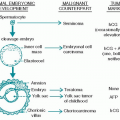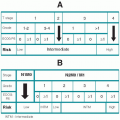AIDS-related Malignancies
Ronald T. Mitsuyasu
I. INTRODUCTION.
Despite great advances in the treatment and survival of individuals infected with the human immunodeficiency virus (HIV), cancer is now one of the leading causes of death in patients with AIDS. In the era of highly active antiretroviral therapy (HAART), patients infected with HIV are living longer than ever, and HAART has greatly reduced the incidence of most of the AIDS-defining cancers, including Kaposi sarcoma (KS), non-Hodgkin lymphoma (including primary central nervous system lymphoma), and invasive cervical carcinoma. Unfortunately, the incidence of other, non—AIDS-defining cancers has increased significantly, and the management of patients who develop malignancies in the setting of HIV remains very challenging.
II. AIDS-RELATED LYMPHOMA
A. Incidence
1. Non-Hodgkin lymphoma (NHL) remains one of the most common AIDSdefining conditions, occurring in approximately 16% of all new cases of AIDS. All age groups and all groups at risk for acquisition of HIV infection are equally likely to develop lymphoma.
2. The incidence of NHL generally tracks with the progressive loss of CD4 lymphocytes. With widespread use of HAART in various areas of the world, resulting in population-wide increases in CD4 cells, the incidence of lymphoma has declined. In this setting, the risk for lymphoma depends on the latest CD4 cell count and not the nadir count.
3. Although the risk of lymphoma has decreased significantly in patients treated with HAART, this decrease in lymphoma has been far less than that seen in KS or the various opportunistic infections, resulting in a relative increase in the occurrence of lymphoma as an initial AIDS-defining illness.
B. Pathology. Most AIDS-related lymphomas are B-cell tumors of high-grade pathologic type. About 60% of patients are diagnosed with immunoblastic lymphoma, plasmablastic or small noncleaved lymphoma; the latter may be Burkitt or Burkitt-like subtypes. In contrast, only 10% to 15% of patients generally with non—HIV-associated lymphoma are diagnosed with one of these more unusual forms of lymphoma. Intermediate-grade, diffuse, large B-cell lymphomas have been reported in 30% to 40%.
Aggressive B-cell lymphomas are expected, but HIV-infected patients also have an increased incidence of low-grade B-cell lymphoma and of various T-cell lymphomas, as well, although they are much less common.
Primary effusion lymphoma (PEL) has also been identified among HIV-infected patients who are also infected with human herpesvirus-8 (HHV-8). PEL is a B-cell neoplasm with the morphologic appearance of an anaplastic or immunoblastic lymphoma. Patients present with malignant serous effusions, usually in the absence of specific mass lesions. Median survival time is in the range of 6 months.
C. Clinical features
1. About 80% of patients with newly diagnosed AIDS-related lymphoma present with systemic B symptoms, consisting of fever, drenching night sweats, and/or weight loss.
2. About 60% to 90% of patients have advanced-stage disease, often presenting in extranodal sites. This occurrence is in sharp distinction to the general lymphoma population, of whom approximately 40% present with extranodal disease.
a. The more common sites of initial extranodal disease include the central nervous system (CNS; about 30% prevalence at diagnosis), gastrointestinal (GI) tract (25%), bone marrow (20% to 33%), and liver (10%).
b. Any anatomic site may be involved, with lymphoma reported in the myocardium, earlobe, gallbladder, rectum, gingiva, and elsewhere.
D. Diagnosis and staging evaluation
1. Biopsy. Immunophenotypic or genotypic studies are often helpful to confirm the monoclonal nature and the histologic subtype of the tumor.
2. Computed axial tomography (CAT) scans. Staging evaluation should begin with CAT scans of the chest, abdomen, and pelvis. Nearly two-thirds of patients with AIDS-related lymphoma have evidence of intra-abdominal lymphomatous disease, which most commonly involves the lymph nodes, GI tract, liver, kidney, and/or adrenal gland. Isolated hepatic or splenic enlargement is not usually seen in the absence of other intra-abdominal findings.
3. Positron emission tomography (PET) scanning is now commonly used in conjunction with CAT scans and can detect more minimal disease activity and may be used posttreatment to differentiate residual active lymphoma from scar and fibrosis. Caution should be taken in the interpretation of PET scans, however, as sites of infection or inflammation, common in the setting of HIV infection, may also yield positive PET scan findings.
4. Bone marrow aspiration and biopsy should be performed.
5. Lumbar puncture (LP). LP should be performed routinely as part of the staging evaluation of patients with AIDS-related lymphoma. About 20% of HIV-infected patients are found to have leptomeningeal involvement even without CNS symptoms. Because prophylactic intrathecal chemotherapy has become an integral part of initial therapy, it is now common practice to inject the first dose of methotrexate or cytosine arabinoside at the time of this initial staging LP in an attempt to prevent isolated CNS relapse. In the presence of active cerebrospinal fluid (CSF) involvement by lymphoma, abnormalities may be relatively minor, with median white cell count of often <10 cells/mL although elevated protein and decreased CSF glucose levels are very often present. Abnormal lymphoma cells are generally clearly recognizable upon cytologic, flow cytometric, or cytogenetic evaluation in those with active disease.
E. Prognostic factors
1. Decreased survival in AIDS-related lymphoma is associated with the following factors:
a. CD4 cells <100/µL
b. Karnofsky performance status <70%
c. Age >35 years
d. Stage IV, especially those with leptomeningeal disease
e. Elevated lactate dehydrogenase in serum
f. Higher IPI scores (2 to 3)
h. Certain subsets of lymphoma (e.g., primary CNS lymphoma, PEL) and perhaps subtypes of DLBCL (e.g., activated B-cell phenotype))
F. Management
1. Use of full-dose chemotherapy regimens. Before the availability of HAART, use of low-dose modifications of standard regimens (such as m-BACOD or CHOP) was advocated because prospective clinical trials indicated that standard-dose regimens were associated with significantly increased toxicity. In the era of HAART, these recommendations are no longer valid.
Studies using full-dose regimens, generally in conjunction with HAART, have shown better outcomes with full-dose and more dose-intensive regimens and with the combined use of rituximab. While responses and progressionfree survival were improved with rituximab, especially when used concurrently with the EPOCH regimen, concerns about poorer outcomes due to infectious deaths have resulted in recommendations for greater use of prophylactic antibiotics and hematopoietic growth factors in this population, especially with CD4 < 100 cells/mm3.
2. Antiretroviral therapy may be used simultaneously with multiagent chemotherapy or may be discontinued during chemotherapy administration and then restarted immediately. If used simultaneously with chemotherapy, zidovudine (AZT) should not be incorporated into the antiretroviral regimen because this drug is myelosuppressive. With this exception, however, pharmacokinetic studies have indicated no clinically significant interactions between HAART (including protease inhibitors) and multiagent antilymphoma chemotherapy. Accepted practice now includes the combined use of chemotherapy with HAART, except in the immediate posttransplant setting.
3. Infusional chemotherapy: (R)-EPOCH. A dose-adjusted EPOCH regimen has been used with excellent results. Three of the five drugs are given by continuous IV infusion (CIV). Cycles are repeated every 21 days for a total of six cycles. The specific dose-adjusted regimen for patients with AIDS is as follows:
Rituximab, 375 mg/m2 IV on day 1 (in the R-EPOCH study)
Etoposide, 50 mg/m2/d on days 1 through 4 by CIV
Doxorubicin (Adriamycin), 10 mg/m2/d on days 1 through 4 by CIV
Oncovin (vincristine), 0.4 mg/m2/d on days 1 through 4 by CIV (with no maximum dose)
Prednisone, 60 mg/m2/d PO on days 1 through 5
Cyclophosphamide IV on day 5; 375 mg/m2 if CD4 ≥ 100; 187 mg/m2 if CD4< 100
a. On subsequent cycles, if the nadir absolute neutrophil count (ANC) was >500 cells/µL, the dose of cyclophosphamide was adjusted in increments of 187 mg/m2 to a maximum dose of 750 mg/m2 IV.
b. Granulocyte colony-stimulating factor was given at a dose of 5 µg/kg/d subcutaneously from day 6 until the ANC was >5,000 cells/µL after the nadir.
c. Intrathecal methotrexate was given at a dose of 12 mg on days 1 and 5 for a minimum of 4 doses prophylactically or until CSF clear of malignant cells in those with active disease.
d. Prophylaxis for Pneumocystis pneumonia was mandated, and prophylaxis against Mycobacterium avium was given to patients with CD4 cells <100/µL.
e. Antiretroviral therapy could be suspended or continued during EPOCH chemotherapy and was reinstituted immediately at the conclusion of the 5-day therapy if held. (Most subjects in the AMC 034 R-EPOCH study remained on HAART during chemotherapy with no increase in toxicities.)
f. Results of EPOCH in AIDS-related lymphoma
(1) In the initial NCI trial, the overall complete remission rate was 74%, including 56% of patients with CD4 cells <100/µL and 87% of patients with CD4 cells >100/µL. With a median follow-up of 56 months, there were only two relapses, and the disease-free survival was 92%. Overall survival at 56 months was 60%, whereas the overall survival of patients with CD4 cells >100/µL at entry was 87%.
(2) In a subsequent randomized, multi-institutional AMC study of concurrent versus sequential R-EPOCH in AIDS-NHL, patients received the same dose-adjusted NCI EPOCH regimen with rituximab administered either concurrently on day 1 of each cycle or weekly for 6 weeks after completing EPOCH therapy. Response rate and 1-year disease-free survival were better in the concurrently treated group (RR: 82% vs. 75% and DFS: 78% vs. 68%). Most patients on study received HAART concurrently along with prophylactic antibiotics and G-CSF with very few infectious complications.
G. Primary CNS lymphoma (PCNSL; see also Chapter 21, Section VIII.C in “Non-Hodgkin lymphoma”)
1. Clinical features. Patients with PCNSL present with far-advanced HIV disease, with median CD4 cells of <50/µL and/or a history of AIDS before the lymphoma. Initial symptoms and signs include seizures, headache, or focal neurologic dysfunction. Isolated subtle changes in personality or behavior may also be seen.






